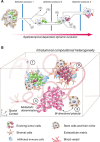Evolving concepts of tumor heterogeneity
- PMID: 25937891
- PMCID: PMC4417538
- DOI: 10.1186/2045-3701-4-69
Evolving concepts of tumor heterogeneity
Abstract
Past and recent findings on tumor heterogeneity have led clinicians and researchers to broadly define cancer development as an evolving process. This evolutionary model of tumorigenesis has largely been shaped by seminal reports of fitness-promoting mutations conferring a malignant cellular phenotype. Despite the major clinical and intellectual advances that have resulted from studying heritable heterogeneity, it has long been overlooked that compositional tumor heterogeneity and tumor microenvironment (TME)-induced selection pressures drive tumor evolution, significantly contributing to tumor development and outcomes of clinical cancer treatment. In this review, we seek to summarize major milestones in tumor evolution, identify key aspects of tumor heterogeneity in a TME-dependent evolutionary context, and provide insights on the clinical challenges facing researchers and clinicians alike.
Keywords: Cancer stem cell; Omic analysis and personalized therapy; Tumor evolution; Tumor heterogeneity; Tumor microenvironment.
Figures


References
Publication types
Grants and funding
LinkOut - more resources
Full Text Sources
Other Literature Sources
Miscellaneous

